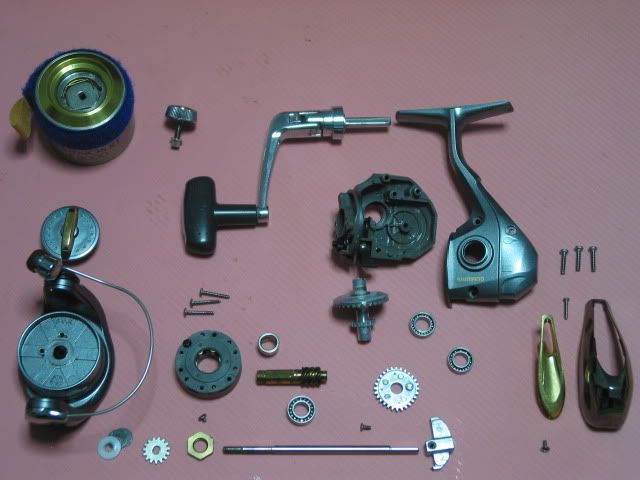 This is a picture intensive posting, but I will put up the images in Thumbnail (as for this series of Reel Maintenance), these images are for reference mainly as there is an old Chinese idiom, a picture is worth more then hundred words.
This is a picture intensive posting, but I will put up the images in Thumbnail (as for this series of Reel Maintenance), these images are for reference mainly as there is an old Chinese idiom, a picture is worth more then hundred words.Most of us started fishing using a spinning reel, as it is easier to operate and also generally cheaper then a conventional reel. And usually your first experience using a spinning reel will be a budget model, either you purchase or borrowed from friends or family member. (No one in his or her right mind will lend an expensive reel to a newbie fisho)
Some friends I know can’t be bothered to service these budget reels, they would only spend money to service the higher end models. However, budget reel can last a long time if one bothers to take a bit of time and effort to keep them in tip top shape. One fishing pal I know of uses the same budget reel and have landed hundreds of fishes, while mine have landed maybe a hundred plus and both of our reels are still going strong.
Many a time anglers are afraid to open up their reels to clean and re-lube them, worried that they will not be able to put everything back together again. Spend a little time and effort, that first reel that your parents buy for you (most likely hidden in your storeroom) could once again become your workhorse and rekindle the fishing passion that have long passes you by.
Before you start, please do make sure that you have the schematic drawing of the reel with you. In the older days, it is printed on a sheet of paper, while nowadays some are printed on the box itself. Having the schematic drawing will guide you along if you have lost your way while putting the reel back.
Some classic reels schematic are available off the web, Google for it if you can't find yours.
Disclaimer - Dismantle your reel at your own risk. I will NOT be liable for any responsibility if you are unable to re-assemble your reel back together.
Tips
- When dismantling the reel, place the items you have remove in sequence. This will help you to remember the sequence when re-assembling the reel.
- Get hold of a digital camera to take pictures while dismantling the reel. Should you have doubts while assembly, you can refer to the pictures.
- If you are looking to upgrade your bushing to bearing, during the servicing do take the measurement of the bushings.
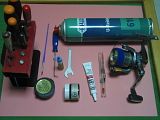 Tools
ToolsScrewdrivers, Spanner, Reel oil, Reel Grease, Pressurized Degreaser or Lighter Fluid.
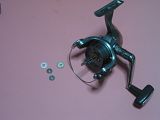
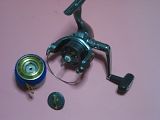 First, unscrew the drag knob and remove the spool.
First, unscrew the drag knob and remove the spool.Next Remove the plastic spacers (if any) and the clicker gear.
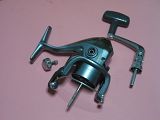 Unscrew the Handle Screw Cap and slide the handle out.
Unscrew the Handle Screw Cap and slide the handle out.
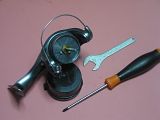 Next Remove the Screw then the Nut from the Rotor.
Next Remove the Screw then the Nut from the Rotor.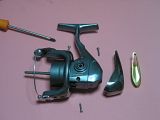
 The Rotor can now be removed. Next remove the Cosmetic body cap by removing all the screws that it holding it in place (1 to 2 screws usually).
The Rotor can now be removed. Next remove the Cosmetic body cap by removing all the screws that it holding it in place (1 to 2 screws usually).Then remove all the screws that are holding the 2 portion of the body. (Usually there is one screw that is hidden under the cosmetic body cap.)
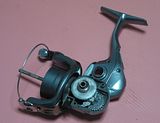
 Remove one half of the body, and you will see the internal of the reel already.
Remove one half of the body, and you will see the internal of the reel already.
 Remove the Bearing (or Bushing in some models) and also the Drive Gear. Next loosen the screw on the Oscillating slider (circled in red).
Remove the Bearing (or Bushing in some models) and also the Drive Gear. Next loosen the screw on the Oscillating slider (circled in red).Remove the screw and slide the Main Shaft out from the front.
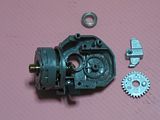 The Oscillating Gear and Oscillating Slider can now be easily be removed, also remove the bearing (or bushing) from the body. In some model, the Oscillating Gear might feather a ball bearing, be sure to remove it as well for cleaning.
The Oscillating Gear and Oscillating Slider can now be easily be removed, also remove the bearing (or bushing) from the body. In some model, the Oscillating Gear might feather a ball bearing, be sure to remove it as well for cleaning.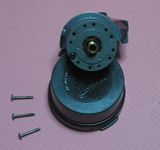
 Now, remove the screws holding the Anti-reverse bearing to the Body (aka one way bearing), circled in Red here.
Now, remove the screws holding the Anti-reverse bearing to the Body (aka one way bearing), circled in Red here.However, be careful NOT to remove the screw (Black Colored screw in this picture) that is holding the bearing assembly; The entire assembly could pop out and the parts flying all over the place.
Check out the reel body for indication for screws holding the assembly to the reel body before removal of any screw.
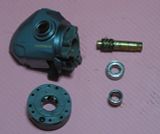
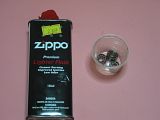 Finally remove the Anti-reverse bearing, Ball Bearing, Pinion gear and Sleeve for the Pinion gear.
Finally remove the Anti-reverse bearing, Ball Bearing, Pinion gear and Sleeve for the Pinion gear.Now your reel body is completely stripped, time to clean all the parts and then put it back together. I use the pressurized degreaser to get the grease and oil off, alternatively soak them in lighter fluid for a while to loosen the grease, oil and dirt. You might need a brush to help removal of these foreign material on the metal parts.
If you think the ball bearing need some cleaning, you can soak them in lighter fluid to get them clean. If your ball bearing cannot spin freely after cleaning, high chance that the bearing is already damaged or rusted. Bring the bearing to a bearing shop or tackle shop to purchase a new one to replace.
Note – Soak only the metal parts in lighter fluid, clean plastic parts with household detergent and water.
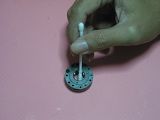 The Anti-reverse bearing are NOT meant to be oil or greased. As it works on friction, thus excess oil and grease could result in it not functioning right. Thus I use the cotton bud to clean off any dirt on the roller surface.
The Anti-reverse bearing are NOT meant to be oil or greased. As it works on friction, thus excess oil and grease could result in it not functioning right. Thus I use the cotton bud to clean off any dirt on the roller surface.Should you worry about rusting, give a very very thin coat of oil or grease after you have clean them. Although you can open up the entire assembly to clean them, I recommend against it as there are a few springs inside and re-assembly can be quite a pain in arse.
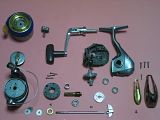 Once you have everything cleaned and ready for assembly, you might want to do a count of the items against the schematic drawing.
Once you have everything cleaned and ready for assembly, you might want to do a count of the items against the schematic drawing.Now time to re-assemble the reel, simply reverse the sequence when you dismantle the reel to assemble the reel back. But before you start, remember to give all moving parts a thin coat of grease, also give a thin coat of grease to all metal parts to prevent corrosion. Oil your bearings before you assemble.
Pointers for assembly.
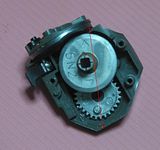
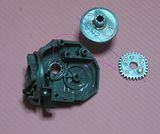 For Shimano Reels, if your Drive gear and Oscillating gear have some triangular pointers, this is what it meant when you are putting them together. The Main Gear pointers and the Oscillating gear pointer are to form a straight line.
For Shimano Reels, if your Drive gear and Oscillating gear have some triangular pointers, this is what it meant when you are putting them together. The Main Gear pointers and the Oscillating gear pointer are to form a straight line.It is shown on the schematic drawing, as mine is in Japanese, I have no idea what it is suppose to do, I suppose it have to do with the gearing alignment.
I notice that the oscillating gear is not in a prefect circle shape, it is sort of squarish. Think it is to assist in laying line evenly across the spool during retrieve.

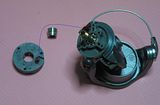 While putting the anti-reverse bearing back, do take note that the little groove at the back of the bearing have to go onto the nipple on the reel body. Failure to do it will result in the anti-reverse not functioning well.
While putting the anti-reverse bearing back, do take note that the little groove at the back of the bearing have to go onto the nipple on the reel body. Failure to do it will result in the anti-reverse not functioning well.Also, do note that the pinion gear sleeve position, the thicker portion is at the top while the thinner portion is to be closer to the body.
 While assembly the main shaft, you might need to turn the gears a little to get a position to put in the screw.
While assembly the main shaft, you might need to turn the gears a little to get a position to put in the screw.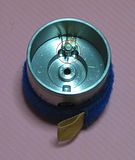 This is an often forgotten step, turn the spool around and you will see the clicker. This is a moving part that could get rusted too, so do remember to oil it before you put the spool back onto the reel.
This is an often forgotten step, turn the spool around and you will see the clicker. This is a moving part that could get rusted too, so do remember to oil it before you put the spool back onto the reel.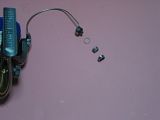
Last time to clean and lube is the roller bearing or bushing. Simple remove the screw and clean the parts inside.
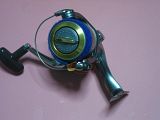 Viola, you reel should be totally assembled by now and have been totally cleaned and re-lube. It should feel almost like new unless you have serious damage to the reel like gear damage or such. I am sure you will tear out some hair here and there, but I do hope this tutorial helps in those hair loss.
Viola, you reel should be totally assembled by now and have been totally cleaned and re-lube. It should feel almost like new unless you have serious damage to the reel like gear damage or such. I am sure you will tear out some hair here and there, but I do hope this tutorial helps in those hair loss.Have fun fishing!!!

0 comments:
Post a Comment